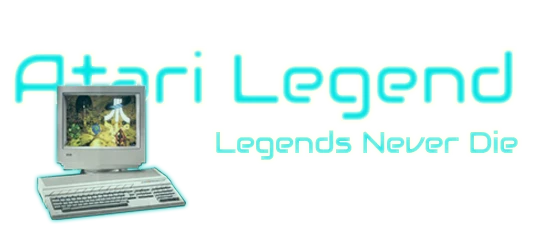

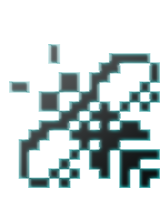





When you look at the resumé of Alain Fernandes, you can only be impressed. He was there from the very early days and is still making games to this day. But most important for us Atari ST fans, Alain was an employee of Titus Software from 1986 till 1991. He converted the classic Crazy Cars and completely coded Fire & Forget. Intrigued? Read on ...
There is currently no profile available in our database

The Texas Instruments 57 Programmable Calculater. Alain encountered these for the first time at school, and he knew he wanted to become a programmer.
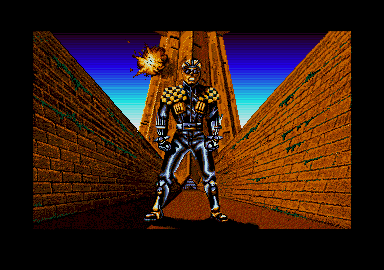
This is the titlescreen of the ST version of Titan. Alain worked on the FM-Towns version, it was his first CD game ever.
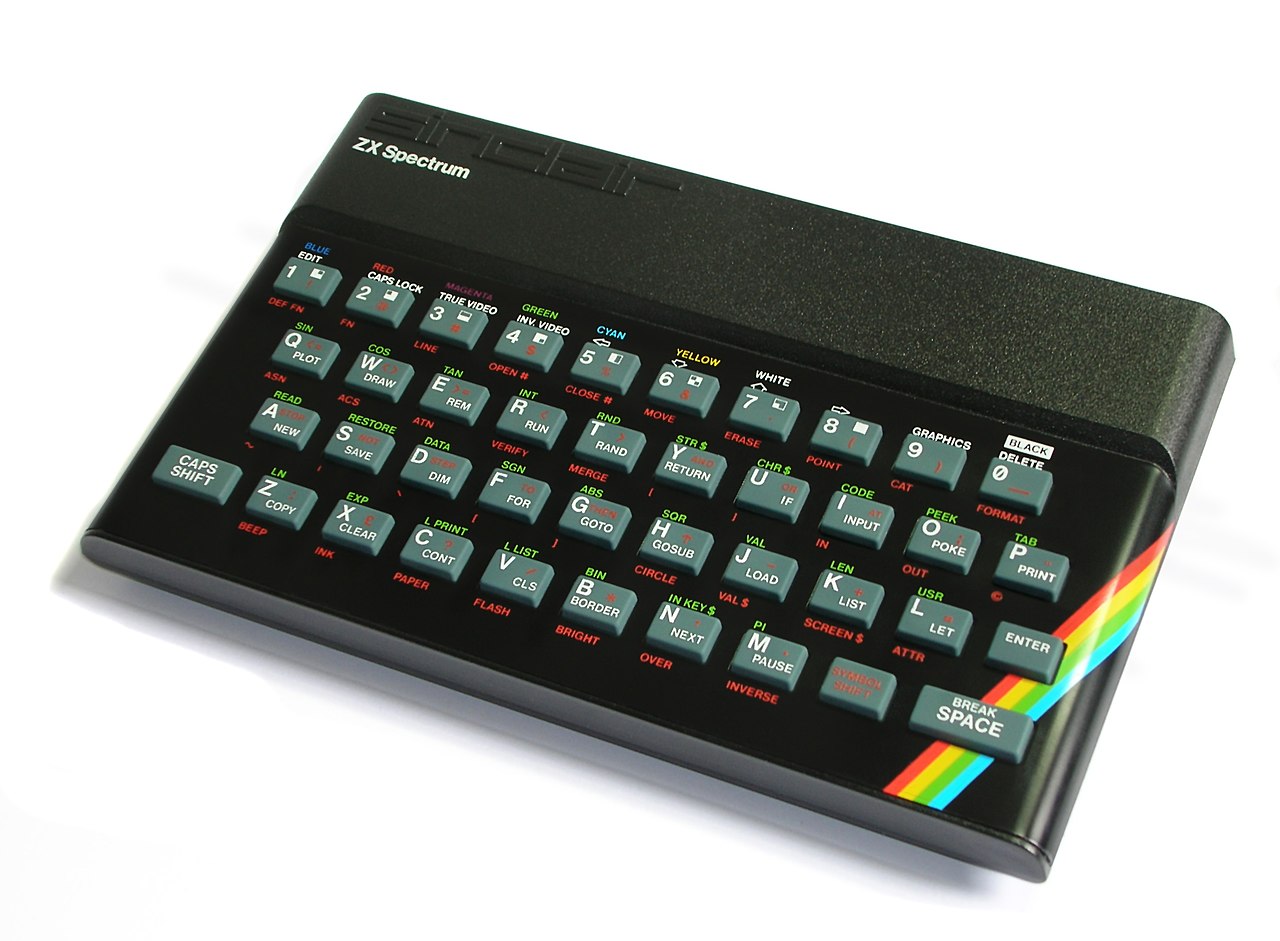
In 1985, when the Atari ST was released, it was still too expensive to compete with the 8 bit systems like this one ... the almighty ZX Spectrum.
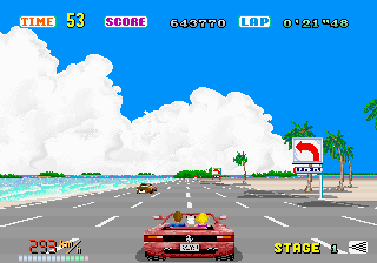
Sega's Outrun was the main inspiration for Crazy Cars. This is a screenshot of the beautiful arcade version.
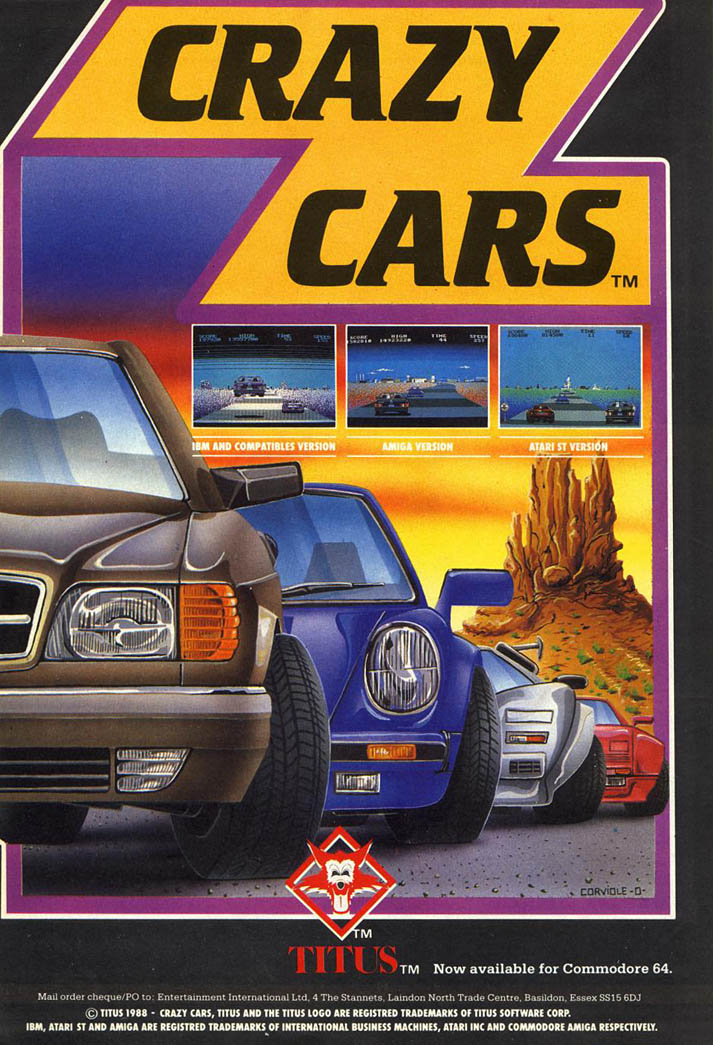
The Crazy Cars box art. The boxes were produced in the same building where Titus had their office. When Alain saw the vast amount of boxes being made ready for shipping, he knew the game was selling well...
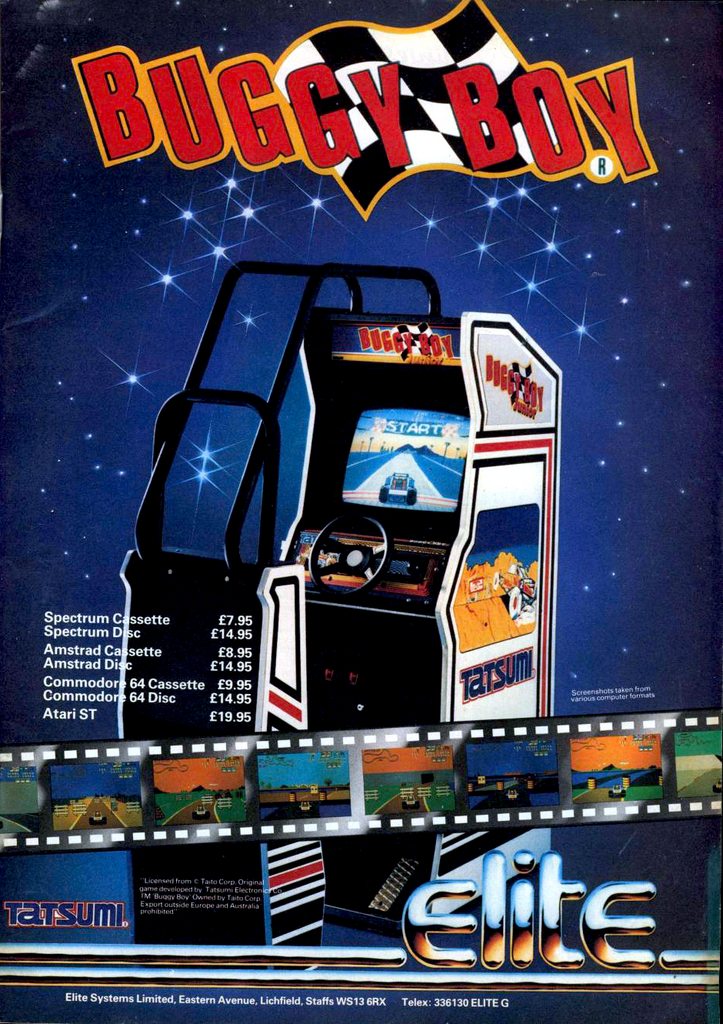
One of my personal favorites on the ST, and look at that arcade cab. Must have been amazing to play.
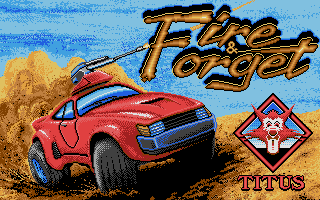
Fire & Forget was completely programmed by Alain. The ST version was first. Afterwards the Amiga conversion was done.
1) Alain, on your website, "In The Pockets", it is stated you started programming in 1980, at the age of only 13, and by 14 years old you created your own games. By 1983, you began working as a professional game developer. But I wonder, in those days, very few people had computers, how did you found out at such an early age, that you wanted to make games? What was your motivation? What started the fascination?
Years before I started programming, I played video games, in 1977 with the Pong console and after that the Atari 2600 console came along.
And even though I loved playing video games, I always wondered, "People are getting paid to create these things?"
But my very first encounter with a programming language, was in September of 1980, during math class.
We had 6 Ti-57 programmable calculators, 1 for the each class. I knew the TI 57-58-59, because I had seen some advertisements in magazines like Micro-Systems.
There were also 'code listings' in computer magazines. You typed in the code, and if you did it well, a working program or game followed. After that I got totally passionate about programming.
In 1981, I bought a Sharp PC 1211 and I spent all my free time programming it.
But it really started when I got the Oric 1. That's when 'bigger' games were becoming possible.
In June 1983, I quit school. I already had one game published and a new one was almost finished.
During summer 1983, I met many game publishers, such as Ere Informatique, Loriciels... and I became friends with Eric Caen, who would later found Titus Software.
The games I did before 1985,
- 'Loup' - Published by TILT - Oric 1 - Basic + Asm 6502
- L'Ete Sera Chaud - Published by SPRITES - Oric 1 - 100% Asm 6502
- Le Diamant de Kheops - Published by SPRITES - Oric 1 - 100% Asm 6502
2) Already in 1985 you started working at the legendary French company Titus, that seems amazing. How did you end up there and how was it working for that company, which was still in its infancy? What do you have the best memories of?
Titus was created by Eric and Hervé Caen, I met Eric Caen several times in 1983 and
1984, at Loriciels and SPRITES. Fun fact, we lived in the same city without knowing it.
In December 1984, Eric and Hervé Caen came to my parents house (I was 17 at the time)
and they asked me if I was interested in working for them. The idea was to make games
for Loriciels, Cedic Nathan, Matra, etc... And of course, I said YES!
The first year at Titus in 1985, I worked on many projects. In 1986, Titus started to publish their own games. ("One", "Erebus", "Maddog" etc.)
I worked for 6 years at Titus Software and I worked on 25 different projects and on 14 different computers.
The best moment was July 1989, where I worked 6 months in Los Angeles at the new "Titus Software" office, programming the game Titan for the Fujitsu FM-Towns.
Even if it was my 29th published game, it was my first game on CD-ROM and it was for Japanese gamers!
3) You created games on various systems but by 1987 work on the Atari ST began. Why the Atari ST? What did you think of the machine? And did you ever own a ST yourself?
Before I started working for video games companies in 1983, I only bought 2 computers.
The Sharp PC 1211 and the Oric 1. After that I started working as a game programmer, video games companies receive each new computer and their tools to create software for them. I never needed to buy a computer.
The Atari ST was released in 1985, at the time it was too expensive to compete
with the 8-bit computers of the time, Amstrad, Zx Spectrum, but in 1987 the price dropped and the market share of the Atari ST was large enough to repay the cost of development and publishing.
4) 1987 saw the release of a game that would start a well known series on the 16 bit computers. Crazy Cars. Whose idea was it to create a racing game and where did it come from? How did the Crazy Cars project begin? What do you remember of its history?
Eric Caen, created the first version of Crazy Cars on the Amiga, programmed in the C language.
At the time, some Titus programmers, like me, spent a few evenings at the Arcade. And Sega's Outrun was a huge hit.
This was the basic idea that served to create Crazy Cars, a race game with existing car models.
5) Crazy Cars was programmed in ASM and C. Do you remember anything in particular when programming the game? Example, what was the hardest thing to do and/or was there anything in particular you were most proud of in the creation of this classic?
I programmed the Atari ST version of Crazy Cars in C and 68000 assembly. It was necessary to use the assembler language for all the display functions and the IO functions. (Keyboard / Joystick).
It was also necessary to create 3D polygons. 11 polygons were used to display the road.
The "C" code on Atari ST takes only 2% of the CPU time, and all display functions written in ASM code takes 98% but that's normal.
Crazy Cars for the Atari ST was my 17th published game, but the first time with such a wide distribution in Europe (also UK) and USA.
6) Wasn’t it expensive to license the cars for the game, since you used real models from Mercedes, Porsche …
Fun fact, at the time you didn't realy need any license....The game market still very small and car companies didn't care (or didn't know?) if you used their logo / models in your games.
7) Was Crazy Cars a commercial success? And did you expect this was going to be a big series?
Remember, I was just a programmer at Titus. I didn't have access to the sales numbers, but I knew it was going well, because the boxes for the game were produces in the same building. When I saw hundreds of Crazy Cars game boxes, I knew it was going well...
8) Crazy Cars was criticised for being too easy, you made up for that with the release of Fire & Forget. This game was a big improvement. How did you come up with this idea? And did it use the same engine as the first Crazy Cars?
I played the arcade game a lot. Fire & Forget was inspired by Spy Hunter (1983),
Buggy Boy (1985) and Spy Hunter II (1987). Lots of good games came out in the arcade first. Of course, 16/32-bit computers changed everything, but before 1987, arcades were the best place to discover future hits.
Unlike Crazy Cars, I programmed Fire & Forget on the Atari ST first before the Amiga version. I worked alone with graphics artist Olivier Corviole. Olivier was the only graphics guy at Titus between 1985 and 1988.
There wasn't really an engine, when you program games, the first step is to write the functions common to all games you're going to make on the same computer.
But of course when you create a new game you optimize your code and you add some new functions.
But you have to recode everything when you reveive a new system/computer and that happened many times during the 80's and 90's .
9) I’m also a very big fan of the later Titus platform games, like The Blues Brothers. This was released in 1991, when you left the company. I was wondering if you have any idea who made this game?
I love The Blue Brothers too, especialy the Nintendo NES version. It was coded by Christophe Gayraud. I worked with him many times, at Titus, Ocean - PAM, Otaboo, In-Fusio.
10) You also programmed the games Antheus and Light Quest. However, I don’t think these games ever made it to the Atari ST (or Amiga). Do you remember what happened to them? And was there anything ever finished for the ST?
Recently I started to rebuild and update Antheus DOS VGA version 360 KB. I hope to receive an positive approval this year, the owner is Laurent Cluzel.
I also recreated a new version of Antheus under with 2018 for modern systems.
The very great game A Forgotten Ghost, an old IOS game of which the gfx were also done by Laurent Cluzel, is also in current development for Windows 10 DirectX.
For Light Quest, I did all the levels, and they were very impressive. The owner of the game is Ubi Soft. I don't know what happened to it.
I also recreated Titan on many modern platforms. I hope to receive an approval some day....
I also recently worked on Jim Power, I hope some day to work on the new version as I know the owner of the game.
11) You have worked on so many games over the years, for various companies, it is impossible to cover them all in this interview. But is there one thing in particular you are most proud of? And if so, why?
In order:
1) Titan - Fujitsu Fm-Towns (1990) I spend six month in LA to create this version. And it was made for the Japanese market!
2) Jim Power - Nec PC-Engine (1992) Another game for the Japanese gamer !
3) Zaps - Doja Phone - (2005) Before IOS, I made some games for In-Fusio, and I am very proud of Zaps. Very close to Mr Nutz, and the graphics were made by Philippe Dussoly.
4) Titan - Apple IOS - (2011) I rewrote «Titan» in C / OpenGL for the Iphone. The game was sold by «Anumam».
5) Geek Room ( Available on my website ). Very proud of this project.
6) Antheus DOS (1990) / Antheus (Remake 2022) The DOS rebuild and the new version are very great.
7) A Forgotten Ghost IOS (2011) Another great game by Laurent Cluzel.
12) What are you up to these days? I think you have started your own company 'In The Pockets'? I see you are converting some of the classics you made in the past, like Antheus in Unity. Will these games be commercially available?
In 2008 / 2009 the "Apps Store" changed everything in the video games industry. Between 2009 and 2015, I made a lot of IOS games and it was a great experience. Since 2015 some companies contacted me to fix/rebuild/update some old games.
13) Do you actually play games? And if so, what is your all time favorite game? (old or new)
I played a lot during my arcade period, 1980-1990, after that I played more at home, Nintendo NES, Nintendo GB and the Sega Dreamcast ... I was big fan of that last console.
And Since 2002, I buy all XBOX games I can get my hands on and many games.... And of course, I'm waiting for GTA VI....
Some of my favorite games... Pac-Man, Galaga, Xenon 2, Lemmings, Destruction Derby, Doom , Far Cry, GTA 3 / 4 / 5, Gears of War, Dead Space...
14) Do you have any last words of wisdom (for the Atari community)?
If you still have an Atari ST, you have to play with Xenon 2 and all other Bitmap Brothers' games. They are fantastic.
Thanks for the interview Alain. For more details check out the complete documentary at the Youtube channel.
August 5, 2025 by grams88
Martin Brownlow is a living legend. Best known among ST fans for creating the beloved PD/shareware classics Grav and Grav 2, his games are still cherished by many to this day. From a young age, Martin knew he wanted to make games for a living...and he made that dream a reality. In fact, he’s still doing it today. Discover the full story and much more in this exciting new interview.
October 4, 2024 by grams88
Stacey Jamieson began his career at DMA Design, working on titles such as Oh No! More Lemmings, Walker, GTA and others. Over the years, he moved on to Electronic Arts (EA), where he contributed to major games like the Star Wars Battlefront series, Mass Effect, and Need for Speed. Today, he is the co-founder of Expression Games, where he continues to pursue his passion for game development. What an exciting career!
July 29, 2024 by grams88
Who doesn't love a good underdog story? Chris Sharp is a noteworthy apprentice of the renowned François Lionet, as he mastered the art of coding with the almighty STOS Basic. Chris crafted a few games for our cherished ST, including fan favourites like Magic Tomb and the Freaked Out series. Intrigued? Dive into our interview to revisit the era when game development could still be a solo endeavour.
July 16, 2024 by grams88
When Sega released its Master System, it came bundled with the game Alex Kid. To this day the game remains very popular, loved by many. One of those people is Terry Lloyd. More so, Alex Kid was the main inspiration for the Atari ST platform classic Axel's Magic Hammer. But that is just one of his many accomplishments. Terry has been around the block. Working as an artist and game designer at the beginning of the 80's for Gremlin Graphics, he then moved on to Core Design, which he helped get off the ground. During the 90's he contributed to founding the company Malibu Interactive. On the Atari ST, Terry's resumé include Dynamite Dux, Car-Vup, Rick Dangerous 1 & 2, Torvak the Warrior, WarZone and many more. Read all about this veteran of the games industry in this exciting interview.
April 18, 2024 by grams88
It doesn't always have to be about computers, coding and graphics. Adrian Powell, the artist behind the original Lemmings game, crafted all its artwork, including box art and promotional materials. His passion for painting lemmings has persisted over time and he is still painting lemmings to this day. Powell's work remains influential and has helped selling millions of copies of this classic (ST) game.
Currently 0 registered users online
In the past 24h there were 4 registered users online